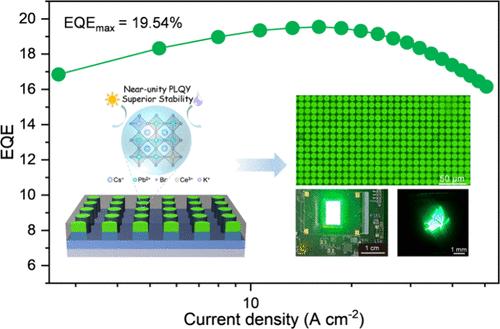用于微型led显示屏的稀土掺杂钙钛矿量子点微球
IF 18.2
1区 材料科学
Q1 CHEMISTRY, PHYSICAL
引用次数: 0
摘要
铯-溴化铅钙钛矿量子点(PeQDs)被认为是实现高性能绿色微米级发光二极管(micro- led)的有前途的颜色转换材料,解决了该领域的“绿色缺口”瓶颈。然而,它们的发光性能和稳定性是否满足微型led应用的严格要求仍不清楚。此外,传统的peqd在高光功率密度激发下表现出明显的发光饱和。为了解决这些问题,我们设计并合成了绿色发光的Ce3+, K+共掺杂的CsPbBr3钙钛矿微球,通过将共掺杂的PeQDs封装在介孔硅球中,同时显示出接近统一的光致发光量子产率和出色的整体稳定性。利用PeQD微球制备的绿色微型led外量子效率高达19.54%,亮度高达4.26 × 107 cd m-2。最后,将绿色微型led阵列与薄膜晶体管背板集成在一起,制造出0.6英寸的led阵列。micro-LED显示。本文章由计算机程序翻译,如有差异,请以英文原文为准。

Rare Earth-Doped Perovskite Quantum Dot Microspheres for Micro-LED Displays
Cesium lead bromide perovskite quantum dots (PeQDs) have been recognized as promising color conversion materials for realizing high-performance green micrometer-scale light-emitting diodes (micro-LEDs) to address the “green gap” bottleneck in this field. However, whether their luminescence performance and stability meet the stringent requirements of micro-LED applications remains unclear. Furthermore, traditional PeQDs exhibit obvious luminescence saturation under high light power density excitation. To address these problems, we design and synthesize green-emitting Ce3+, K+ codoped CsPbBr3 perovskite microspheres by encapsulating codoped PeQDs in mesoporous silica spheres, demonstrating simultaneous near-unity photoluminescence quantum yields and exceptional overall stability. Green micro-LEDs, prepared by using the PeQD microspheres, achieve an external quantum efficiency of up to 19.54% and a high brightness of 4.26 × 107 cd m–2. Finally, green micro-LED arrays were integrated with a thin-film transistor backplane to fabricate a 0.6 in. micro-LED display.
求助全文
通过发布文献求助,成功后即可免费获取论文全文。
去求助
来源期刊

ACS Energy Letters
Energy-Renewable Energy, Sustainability and the Environment
CiteScore
31.20
自引率
5.00%
发文量
469
审稿时长
1 months
期刊介绍:
ACS Energy Letters is a monthly journal that publishes papers reporting new scientific advances in energy research. The journal focuses on topics that are of interest to scientists working in the fundamental and applied sciences. Rapid publication is a central criterion for acceptance, and the journal is known for its quick publication times, with an average of 4-6 weeks from submission to web publication in As Soon As Publishable format.
ACS Energy Letters is ranked as the number one journal in the Web of Science Electrochemistry category. It also ranks within the top 10 journals for Physical Chemistry, Energy & Fuels, and Nanoscience & Nanotechnology.
The journal offers several types of articles, including Letters, Energy Express, Perspectives, Reviews, Editorials, Viewpoints and Energy Focus. Additionally, authors have the option to submit videos that summarize or support the information presented in a Perspective or Review article, which can be highlighted on the journal's website. ACS Energy Letters is abstracted and indexed in Chemical Abstracts Service/SciFinder, EBSCO-summon, PubMed, Web of Science, Scopus and Portico.
 求助内容:
求助内容: 应助结果提醒方式:
应助结果提醒方式:


